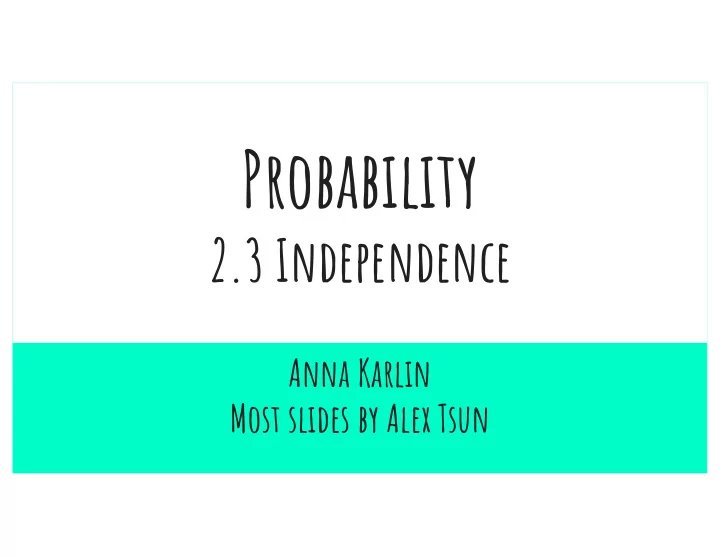

Probability 2.3 Independence Anna Karlin Most slides by Alex Tsun
Agenda ● Chain Rule ● Independence ● Conditional Independence in class not
Chain Rule (Idea) Have a Standard 52-Card Deck. ● 4 Suits (Clubs, Diamonds, Hearts, Spades) ● 13 ranks (A, 2, 3, …, 9, 10, J, Q, K)
Chain Rule (Idea) Have a Standard 52-Card Deck. Shuffle It, and draw the top 3 cards. A : Ace of Spades First What is P ( ) = P( A, B, C )? B : 10 of Clubs Second C : 4 of Diamonds Third
Chain Rule (Idea) Have a Standard 52-Card Deck. Shuffle It, and draw the top 3 cards. A : Ace of Spades First What is P ( ) = P( A, B, C )? B : 10 of Clubs Second C : 4 of Diamonds Third e P PIA c An B PCB f A
Chain Rule (Idea) Have a Standard 52-Card Deck. Shuffle It, and draw the top 3 cards. (uniform probability space). A : Ace of Spades First B : 10 of Clubs Second C : 4 of Diamonds Third What is P ( ) = P( A, B, C )? A B C E w AnBnc An B
Chain Rule peps A p y c
Chain Rule (Idea) Prf E Irl Have a Standard 52-Card Deck. Shuffle It, and draw the top 3 cards. (uniform probability space). Irl 52 51.50 A : Ace of Spades First B : 10 of Clubs Second TT C : 4 of Diamonds Third What is P ( ) = P( A, B, C )? P B P 2nd card d LT D P An B i so si
stIsIs rgp fmbjml.it yEo so IT I PCBlAI PrfAy Fun with cards Two people, A and B, are playing the following game. A 6-sided die is thrown and each time it’s thrown, regardless of the history, it is equally likely to show any of the six numbers If it shows 5, A wins. If it shows 1, 2 or 6, B wins. Otherwise, they play a second round and so on. What is Pr(A wins on 4 th round)? worksheet section will be on rule chain use
The need for independence P HAB
The need for independence
Independence
14 Independence ● Toss a coin 3 times. Each of 8 outcomes equally likely. Define ● A = {at most one T} = {HHH, HHT, HTH, THH} ● B = {at most 2 Heads}= {HHH} c ● Are A and B independent? P4AnB PrlB PrlA THH HTH AAB HHT 8t a Is b 6 42 37 PlAnB PFA PCB F d not indep
p q B Network Communication A D Each link works with the probability C s r given, independently . What’s the probability A and D can communicate? PCC tPCD P CUD Plt top path works T Ppl BBjBpD p whence ED works Be bottom palm p 9 are independent ros PCB P PCD PCCND PfthB P T tPlB PFF working P TUB path sa t Pri if Y.SI I pEspus7 a P97ltrs nnodffndep 0
PCD 14 0 P D p q B Network Communication A D Each link works with the probability C s r given, independently . What’s the probability A and D can communicate?
17 Using independence to define a probabilistic model ● We can define our probability model via independence. ● Example: suppose a biased coin comes up heads with probability 2/3, independent of other flips. e Hit r ● Sample space: sequences of 3 coin tosses. Iii ● Pr (HHH)=? ● Pr (TTT) = ? ● Pr (HHT) = ? Iii ● Pr (HTH) = ? ● Pr (2 heads) = ? 50 4 d E5 Prc I
PITHH P HAD PLATH T h's PRCH.TL 3 1353435 wEePriw3f5t3IPgI.PLIg IzI PCED Probability FI's 3.1 Discrete Random Variables Basics Anna Karlin Most slides by Alex Tsun
Agenda ● Intro to Discrete Random Variables ● Probability Mass Functions ● Cumulative Distribution function
Flipping two coins Fandom variable
Flipping two coins r sety possible values X si 1 191,23 Ft
Random Variable
Random Variable
Recommend
More recommend